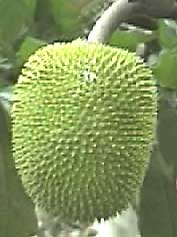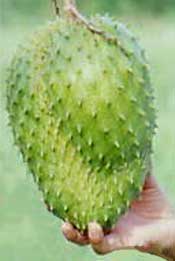
We also call them papaya in English and they come from a small, soft-wooded, more or less umbrella-shaped tree, Carica
papaya, of the papaya family. The fruit can be the size of a watermelon, is
mostly yellowish, and its flesh is very subtle in taste. Papayas at the best stage for
eating often look bruised and discolored. Have the vendor pick a good one for you, and
then cut out the bruised-looking parts. Discard the black seeds. Papayas are famed for
aiding digestion.
 This is the
fruit of a large tree, Artocarpus altilis, native to Polynesia,
and introduced to the West Indies in 1792 by the infamous Captain Bligh. Many
horticultural varieties are known, most of them seedless. The extremely sticky, whitish
pulp is usually boiled as a vegetable, or roasted. When roasted, the flesh vaguely
resembles bread. It's too bitter and sticky to eat raw.
This is the
fruit of a large tree, Artocarpus altilis, native to Polynesia,
and introduced to the West Indies in 1792 by the infamous Captain Bligh. Many
horticultural varieties are known, most of them seedless. The extremely sticky, whitish
pulp is usually boiled as a vegetable, or roasted. When roasted, the flesh vaguely
resembles bread. It's too bitter and sticky to eat raw.
Cherimoya is a fruit of a small tree, Annona cherimola, native to the Andes, and closely related to the guanábana shown below, but considerably smaller, and the skin is only slightly scaly. The flesh is sweet. Its pulp contains many bean-size seeds.
 This is the fruit of a small tree, Annona muricata
of the custard apple family, native to tropical America. Its flesh is white, very slightly
acid, with a pleasant taste, and containing numerous bean-size seeds. It's closely related
to the cherimoya, which also is eaten raw. As you see in the photo at the right, guanábana
skin is normally armored with numerous soft, short, blunt spines.
This is the fruit of a small tree, Annona muricata
of the custard apple family, native to tropical America. Its flesh is white, very slightly
acid, with a pleasant taste, and containing numerous bean-size seeds. It's closely related
to the cherimoya, which also is eaten raw. As you see in the photo at the right, guanábana
skin is normally armored with numerous soft, short, blunt spines.
Coconuts, as we call them in English, are fruits of the
palm tree Cocos nucifera, which is at home along beaches
throughout the entire tropical world. Its original homeland is unknown. When you buy a
coconut, remember that the quantity of "milk" in it is inversely proportional to
the amount of "meat." A coconut with a lot of sweet milk may have almost no
meat, but a good, meaty one may be almost dry. If you buy a coconut for drinking, the
vendor will cut off the nut's top with a machete, and you can drink the milk through a
straw.
We Northerners know all about pineapples, Ananas
comosus, of course, but they deserve special mention if only because they're
so interesting botanically. The edible part of a pineapple is actually greatly thickened,
pulpy stem material. The actual fruits, which are berries, are imbedded in this
tissue. Moreover, pineapple plants are actually bromeliads... And bromeliads are those
agavelike plants you see festooning tree limbs in tropical Mexico. The plant is native to
the American tropics and, unlike most other bromeliads, grows on the ground. The best way
to judge whether a pineapple is ready to eat is by smelling for its mellow, sweet odor.